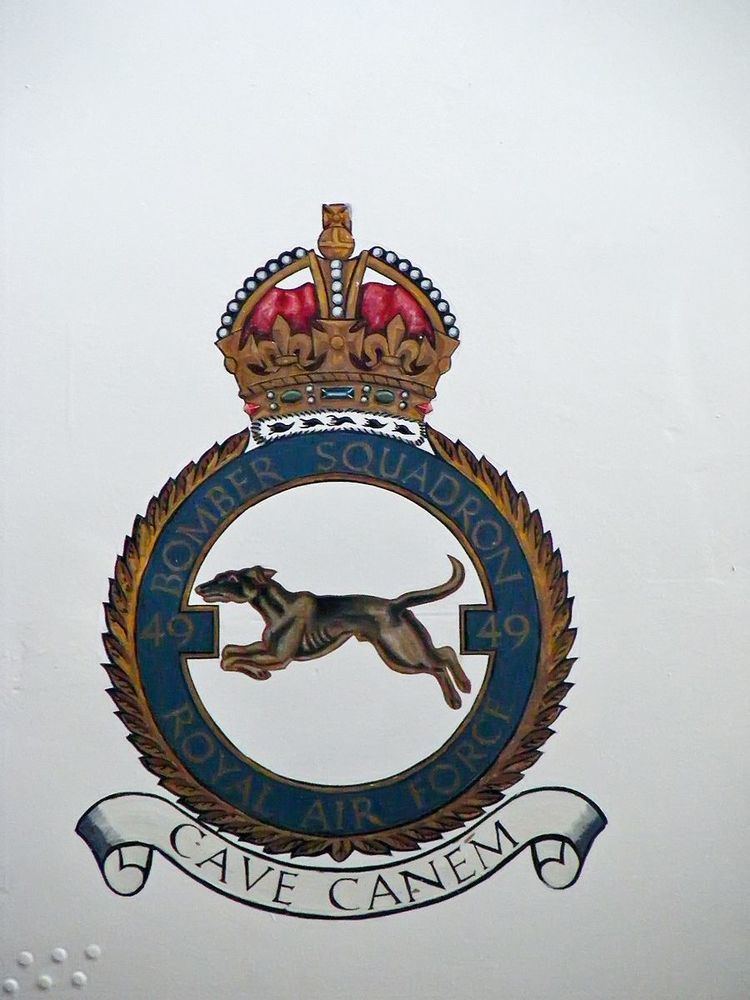Country United Kingdom | ||
 | ||
Active 15 Apr 1916 – 18 July 1919,10 Feb 1936 - 1 Aug 19551 May 1956 – 1 May 1965 Motto(s) Latin: Cave canem("Beware of the Dog") Battle honours Western Front, 1917-18*: Cambrai, 1917*: Somme, 1918*: Channel & North Sea, 1939-40: France & Low Countries, 1940: Invasion Ports, 1940: German Ports 1940 -45*: Ruhr, 1940 - 45*: Fortress Europe, 1940 -44*: Berlin, 1943-44*: Italy, 1943-44: Biscay Ports, 1943: Normandy, 1944: France & Germany, 1944-45*: Walcheren: Rhine: Honours marked with an asterisk are those emblazoned on the Squadron Standard Squadron badge heraldry A greyhound courant. The greyhound is indicative of speed. | ||
No. 49 Squadron was a bomber squadron of the Royal Air Force from 1938 to 1965. They were the first squadron to receive the Hampden in September 1938.
Contents
They squadron achieved notoriety through the Victoria Cross awarded to Rod Learoyd on a raid in 1940 and for being the squadron which dropped the atomic bombs in Operation Grapple.
History
The squadron was formed at Swingate Down, near Dover, Kent, England in April 1916. In November 1917, the squadron deployed to France and their first operation was in the Battle of Cambrai. When the First World War ended, 49 Squadron became part of the occupying forces and disbanded in Germany in July 1919.
The squadron was reformed in February 1936 from 'C' flight on No. 18 Squadron at RAF Bircham Newton. The squadron initially reformed with Hind aircraft and relocated to RAF Scampton in March 1938. In September of the same year, the squadron started accepting Hampden aircraft, the first operational squadron to do so.
During the Second World War they carried out the attack on the Dortmund-Ems Canal on 12 August 1940. In 1942 No.49 Squadron converted to Manchesters, then Lancasters, and in October led No.5 Group's epic dusk attack on the Schneider armament and locomotive works at Le Creusot. In 1943 the squadron took part in the first "shuttle-bombing" raid (when the targets were Friedrichshafen and Spezia), and the famous raid on Peenemunde. Among the targets which it attacked during 1944 were the coastal gun battery at La Pernelle on the Normandy coast, and the V-1 flying bomb storage sites in the caves at St. Leu d'Esserent on the River Loire, some 30 miles north-west of Paris. In December 1944, it took part in a raid on the German Baltic Fleet at Gdynia and in March 1945, was represented in the bomber force which so pulverised the defences of Wesel just before the crossing of the Rhine that Commandos were able to seize the town with only 36 casualties.
The Squadron remained with Lancasters until it was re-equipped with Lincolns in November 1949. They carried out 2 tours of duty during the Kenyan Mau Mau Uprising from November 1953 to January 1954 and from November 1954 to July 1955. During both these tours it was commanded by Squadron Leader Alan E. Newitt DFC. After returning to the UK, the squadron was disbanded at RAF Upwood on the 1 August 1955.
During their second tour of operation Avro Lincoln SX984 was lost in an accident.
They operated the Vickers Valiant from RAF Wittering and RAF Marham from 1 May 1956 until 1 May 1965.
The sole remaining Vickers Valiant (XD818) - the one that dropped the first British hydrogen bomb at Christmas Island with 49 Sqn as part of Operation Grapple - is preserved at the RAF Museum Cosford, near Wolverhampton.
SX984 Avro Lincoln
The SX984 was lost in a crash on 19 February 1955 while serving in Kenya during the Mau Mau Uprising.
On returning from an operational bombing sortie at 1540 hours, some 1hr 25mins flying time (total airborne time to the moment of the crash was 1hr 33mins), the pilot of SX984 carried out several unauthorized low passes over the police hut at Githunguri, where another 49 squadron crew was paying a visit. On the third such pass SX984 struck the roof of the hut and a telegraph pole, breaking off part of the wing and some of its nose. It went into a steep climb, stalled and crashed to the ground 8 miles north north west of Kiambu killing five members of the crew and four civilians on the ground. A visiting crew member called Pierson managed to pull the Rear Gunner from the wreckage but he died a few hours later of his injuries.
The finding of the Board of Inquiry was that the accident was caused by wilful disobedience of orders and unauthorized low flying.
There is a memorial window to the crew and civilians killed in the crash in St Leonard's Church, Sandridge in Hertfordshire, UK.
